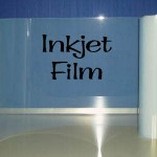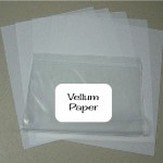 What’s the best media for screen printers to use for creating film positives? It comes down to a matter of cost, time, and availability. There are a few other issues worth noting and we’ll discuss them here as well.  In this article, we going to limit our discussion to vellum paper and inkjet film as they are the two most common types of media used for creating film positives by screen printers. Let’s start with vellum paper… Vellum paper is a translucent type of paper. It comes in two types: laser printer ready and inkjet printer ready. The laser printer vellum is far more common and much easier to find than the inkjet version. The advantages of laser ready vellum paper is low cost, runs quickly through your laser printer, and is available in a variety sizes. It is sold by most screen printing supply vendors and can be ordered from specialty print supply companies as well. If you are printing line art and medium sized text (14 pt. or higher), it works reasonably well. It is less than ideal for making screens with images that contain halftones, fine lines, or small type. Consider it a workhorse for making screens with run of the mill, simple artwork. Another disadvantage is vellum paper will shrink slightly when running through a laser printer and this will cause registration problems for creating film positives for multi-color screen printing. A tip for creating a nice, dark film positive that is easier to expose when burning a screen is to use a special spray on chemical that you apply to the printed image. Commercial toner darkener spray (available at your screen printing supplier) and (believe it or not) some brands of hair spray will make the black image on your film positive much darker–making so much easier to expose and wash out the image on the screen. There are several manufacturers of laser ready vellum paper and our experience is that they all seem to work with similar results.  Now let’s talk about inkjet film… If it were not for the cost and the increased time it takes to output the image through your printer and its cost, inkjet film would be a complete no-brainer. It produces film positives with completely opaque images that are easy to burn; and for creating film positives containing halftone images, it is the ideal medium. On the downside, the time it takes to output the film is of course dependent on your printer but certainly not as fast as you could output with a laser printer. For creating film positives for multi-color jobs, inkjet film is ideal, as there is no shrinkage. The major disadvantage of inkjet film is cost. It is much more costly than laser vellum paper. Inkjet film comes in both rolls and sheet versions, depending on the type of printer you have. There are several manufacturers of inkjet film for making film positives for screen printing. Our experience is that all brands do not work equally well. We recommend that you obtain samples of different brands and test them out before making a large quantity purchase. So what is the bottom-line recommendation? We recommend using both types of media. Laser vellum for non-critical, “run of the mill” single color print jobs and inkjet film for print jobs that have small type, tiny lines, halftones, or multi-colors.
0 Comments
Your comment will be posted after it is approved.
Leave a Reply. |
AuthorASPA Staff and others Archives
April 2023
Categories
All
|
Copyright © 2004-2024 American Screen Printing Association Inc. (ASPA) | The #1 Ranked Screen Printing Association on the Web | All Rights Reserved.


 RSS Feed
RSS Feed